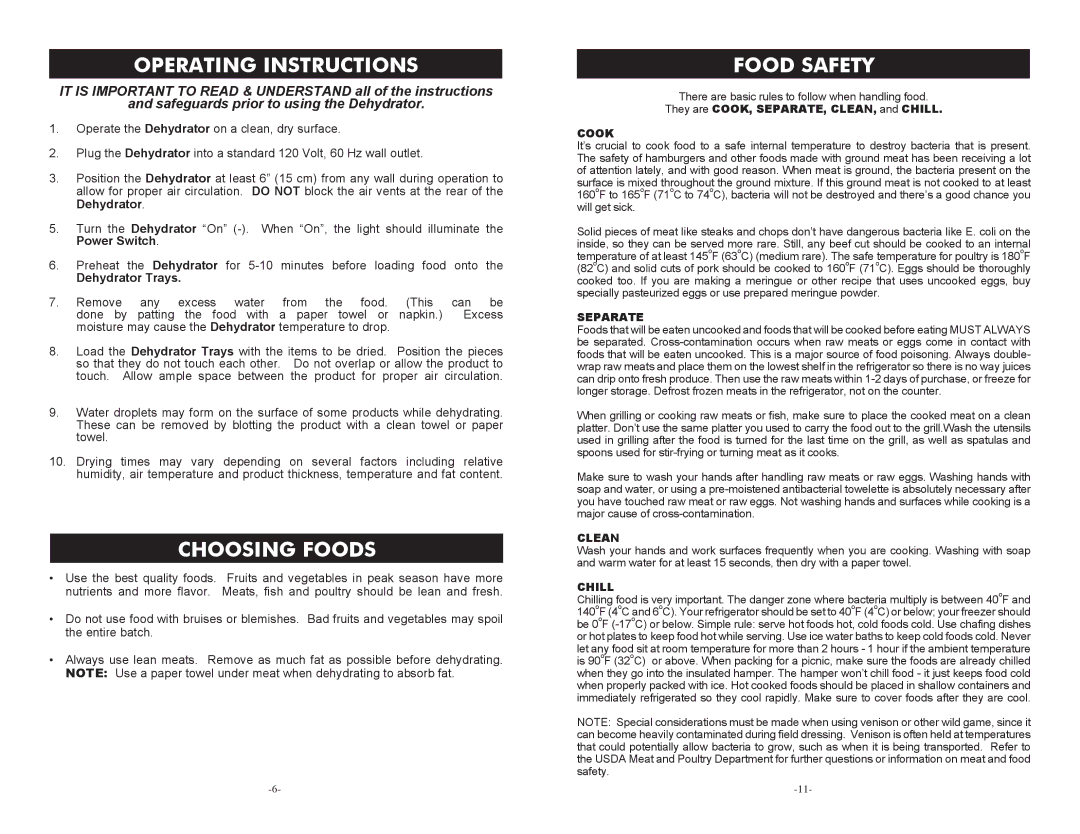
OPERATING INSTRUCTIONS
IT IS IMPORTANT TO READ & UNDERSTAND all of the instructions
and safeguards prior to using the Dehydrator.
1.Operate the Dehydrator on a clean, dry surface.
2.Plug the Dehydrator into a standard 120 Volt, 60 Hz wall outlet.
3.Position the Dehydrator at least 6” (15 cm) from any wall during operation to allow for proper air circulation. DO NOT block the air vents at the rear of the Dehydrator.
5.Turn the Dehydrator “On”
6.Preheat the Dehydrator for
Dehydrator Trays.
7. Remove any excess water from the food. (This | can be |
done by patting the food with a paper towel or napkin.) | Excess |
moisture may cause the Dehydrator temperature to drop. |
|
8.Load the Dehydrator Trays with the items to be dried. Position the pieces so that they do not touch each other. Do not overlap or allow the product to touch. Allow ample space between the product for proper air circulation.
9.Water droplets may form on the surface of some products while dehydrating. These can be removed by blotting the product with a clean towel or paper towel.
10.Drying times may vary depending on several factors including relative humidity, air temperature and product thickness, temperature and fat content.
CHOOSING FOODS
•Use the best quality foods. Fruits and vegetables in peak season have more nutrients and more flavor. Meats, fish and poultry should be lean and fresh.
•Do not use food with bruises or blemishes. Bad fruits and vegetables may spoil the entire batch.
•Always use lean meats. Remove as much fat as possible before dehydrating. NOTE: Use a paper towel under meat when dehydrating to absorb fat.
FOOD SAFETY
There are basic rules to follow when handling food.
They are COOK, SEPARATE, CLEAN, and CHILL.
COOK
It’s crucial to cook food to a safe internal temperature to destroy bacteria that is present. The safety of hamburgers and other foods made with ground meat has been receiving a lot of attention lately, and with good reason. When meat is ground, the bacteria present on the surface is mixed throughout the ground mixture. If this ground meat is not cooked to at least 160oF to 165oF (71oC to 74oC), bacteria will not be destroyed and there’s a good chance you will get sick.
Solid pieces of meat like steaks and chops don’t have dangerous bacteria like E. coli on the inside, so they can be served more rare. Still, any beef cut should be cooked to an internal temperature of at least 145oF (63oC) (medium rare). The safe temperature for poultry is 180oF (82oC) and solid cuts of pork should be cooked to 160oF (71oC). Eggs should be thoroughly cooked too. If you are making a meringue or other recipe that uses uncooked eggs, buy specially pasteurized eggs or use prepared meringue powder.
SEPARATE
Foods that will be eaten uncooked and foods that will be cooked before eating MUST ALWAYS be separated.
When grilling or cooking raw meats or fish, make sure to place the cooked meat on a clean platter. Don’t use the same platter you used to carry the food out to the grill.Wash the utensils used in grilling after the food is turned for the last time on the grill, as well as spatulas and spoons used for
Make sure to wash your hands after handling raw meats or raw eggs. Washing hands with soap and water, or using a
CLEAN
Wash your hands and work surfaces frequently when you are cooking. Washing with soap and warm water for at least 15 seconds, then dry with a paper towel.
CHILL
Chilling food is very important. The danger zone where bacteria multiply is between 40oF and 140oF (4oC and 6oC). Your refrigerator should be set to 40oF (4oC) or below; your freezer should be 0oF
NOTE: Special considerations must be made when using venison or other wild game, since it can become heavily contaminated during field dressing. Venison is often held at temperatures that could potentially allow bacteria to grow, such as when it is being transported. Refer to the USDA Meat and Poultry Department for further questions or information on meat and food safety.
